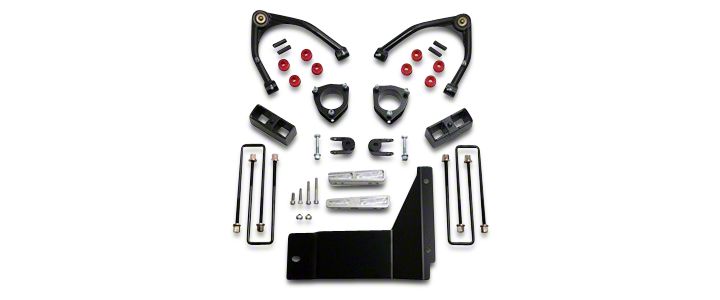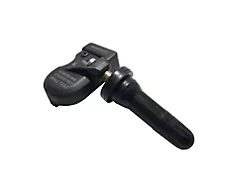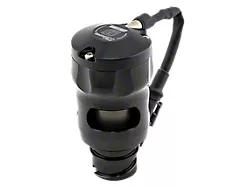
How to Install ReadyLIFT 4 in. Front / 1.75 in. Rear SST Lift Kit on your Silverado

Shop Parts in this Guide
Raise vehicle and support frame with jack stands

Remove wheels/tires

Remove front plastic debris plate.

Disconnect ABS sensor at the frame.

Unbolt ABS bracket from upper control arm.

Disconnect and remove both sway bar endlinks.

Remove outer tie rod nut

Strike spindle with hammer to break loose tie rod

Remove lower strut mounting hardware, remove nut clips

Remove clips from top of upper strut mounting nuts

Remove upper mounting nuts

Remove strut assembly from vehicle.

Loosen but do not remove upper ball joint nut

Strike spindle as shown to break loose ball joint, disconnect

Use pry bar to push down upper control arm, remove nut

Carefully separate ball joint from spindle

Unbolt upper control arms hardware, note cam location

Remove upper control arms

Unplug differential solenoid

Disconnect U-joint straps at differential yoke, slide back

Unbolt CV axles (6) bolts at the differential

Unbolt rear cross member (4) bolts and remove

Support differential with jack and un-bolt passenger side

Remove driver side mounting bolts and unplug vent line

Carefully lower differential from vehicle

Secure differential to perform modification

Mark differential as shown indicating material to be removed

Use a grinder to remove material marked previously

Remove passenger side differential mounting bracket

Secure in vise and remove mounting studs with hammer

Reinstall bracket and attach billet spacer as shown

Attach passenger/driver side with socket head hardware

Raise and position diff back into vehicle check clearance

Attach with new hardware and reconnect differential vent line

View of passenger side bolted in with new hardware

Reconnect differential solenoid

Reinstall rear cross member as original

Now install new upper control arms to frame with OE hardware

Place new strut extension spacer onto strut

Attach and tighten with OE hardware

Reinstall strut assembly into vehicle with new hardware

Attach lower strut mount with new shorter hardware, no clips

Raise spindle, reattach upper ball joint and tighten, cotter pin

Reconnect outer tie rod end and tighten

Reattach CV axles to differential (6) bolts and tighten

Reconnect ABS plug near frame

Attach ABS/brake line bracket to upper control arm

Install new differential skid plate w/ 3 self tapping bolts
Note: The following installation instructions cover both the 2/4WD 1500 pick-ups and the 2/4WD Avalanche, Tahoe, Suburban, Yukon, Yukon XL, and Escalade/EXT. This kit will work on vehicles with AutoRide, not AutoLeveling, unless the end users is willing to make modifications. ReadyLIFT does not supply parts and or methods to accommodate vehicles with this option.

Unclips ABS/traction control lines at the frame

Disconnect and remove rear shocks from vehicle

Install shock extensions to upper shock mount as shown

With axle supported remove u-bolts from laxle

Carefully lower axle and remove factory block, do not reuse

Lower axle more in order to install new lift block

Raise axle align and attach new u-bolts and hardware

Reinstall shock with extension attached and tighten

Lube ABS wire and slide rubber mount up to gain more slack

Attach ABS wire to u-bolts with provided zip ties

Differential brake line bracket made require bending up

Disconnect ABS/TC line at the axle to avoid damage.

Disconnect and remove sway bar end links and shocks

At the differential, install spacer and hardware as shown

Lower axle and remove coil springs and isolators

Mark center of bump stop pad and drill 11/32 hole

Use self-tapping bolt and attach bump stop extension

Place Upper coil spacer nut plate above coil housing

Attach coil spring spacer to nut plate and tighten

Reinstall isolators and coil springs and raise axle

Reinstall shocks with extensions as shown and tighten

Install new longer sway bar end links and tighten
Reinstall wheels/tires and lower to the ground. Recheck all work performed, check for proper clearance at full turn and while in reverse. Torque all hardware to spec. Test drive and re-torque u-bolts and wheels. Have vehicle aligned.

Final Checks & Adjustments
Post Installation Warnings: Once the vehicle is lowered to the ground, check all parts which have rubber or urethane components to insure proper torque. Torque wheels to factory specs. Move vehicle backwards and forwards a short distance to allow suspension components to adjust. Turn the front wheels completely left then right and verify adequate tire, wheel, brake line, and ABS wire clearance. Test and inspect steering, brake and suspension components for tightness and proper operation. Inspect brakes hoses and ABS lines for adequate slack at full extension. Failure to perform the post inspection checks may result in vehicle component damage and/or personal injury or death to driver and/or passengers. Test drive vehicle and re-check the torque of all fasteners and re-torque wheels on vehicle. Readjust headlamps.
Vehicle Handling Warning: Vehicles with larger tires and wheels will handle differently than stock vehicles. Take time to familiarize yourself with the handling of your vehicle.
Wheel Alignment/Headlamp Adjustment:
It is necessary to have a proper and professional wheel alignment performed by a certified alignment technician. Align the vehicle to factory specifications. It is recommended that your vehicle alignment be checked after any off-road driving. In addition to your vehicle alignment, for your safety and others, it is necessary to check and adjust your vehicle headlamps for proper aim and alignment
Vehicle Re-Torque and Safety Inspection:
Upon completion of all services and adjustments performed on your vehicle, and within 50 miles of driving, check to ensure all fasteners and hardware are properly torqued to specification as noted in the vehicles factory service manual or the torque chart included.














